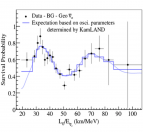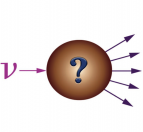Neutrino Physics
Neutrino Oscillation
Neutrino oscillations arise from a quantum mechanical phenomenon associated with the fact that the neutrinos have mass. For the three neutrinos species that we know to exist, the principle of superposition allows "flavor" states, namely neutrinos that interact to produce electrons, muons, or taus, to be (orthogonal) combinations of three neutrino states with definite mass. In other words, when a weak interaction produces a flavor state, such as a muon neutrino, that state is a mixture of states with different mass. These states evolve at different rates so that a later time, the state may acquire some component of a new flavor state, such that if it interacts, it may do so as a flavor state different from its original flavor. This possibility of flavor change, namely that a neutrino is created in one flavor and interacts some time later as another, is the primary manifestation of neutrino oscillations.

Big Questions

The observation of neutrino oscillations in 1998 by the Super-Kamiokande experiment, established that neutrinos have non-zero and non-degenerate masses. Around the same time, the SNO experiment definitively showed that electron neutrinos born in the core of the sun, transition to a mixture of all three flavors, explaining the fewer-than-expected number of electron neutrinos detected on Earth. These developments shared the 2015 Nobel Prize in Physics "for the discovery of neutrino oscillations, which shows that neutrinos have mass. These discoveries and subsequent developments have opened a vast new program of research which seeks to answer questions regarding neutrino flavor and masses and their role in the universe. These include:
- Do neutrinos and antineutrinos oscillate in the same way? Or do they exhibit "CP violation", an asymmetry between matter and antimatter?
- Is there a pattern in the fundamental parameters which relate the neutrino flavor and mass states that point to new symmetries or physics?
- What is the pattern of neutrino masses and why are they so small, more than a million times smaller than the electron, the next lighest particle? Do they get masses from a different source than other particles (e.g. the Higgs mechanism)?
- Are there additional species of neutrnos than those we know about? Do they have exotic properties that can't be explained by the Standard Model?
What role do neutrinos have in the evolution of the Universe? Are they the reason for why the universe is matter dominated?

Detecting Neutrinos

BIG detector: One of the defining properties of neutrinos is their extremely feeble interaction with other particles. While increasingly powerful accelerators with proton beams approaching 1 megawatt of power are being used to produce neutrinos, enormous detectors with tons (for near/short base line detectors ~100 m away from the source) or kilotons (for far detectors ~1000 km from the source) of mass are needed in order to obtain enough observations of neutrino interactions to make precise measurments of neuttrino properties, including neutrino oscillations.
Neutrino-Nuclear Cross-sections: In order to make enormous neutrino detectors, we have turned to cheap and abundant materials that nonetheless allow us to observe neutrino interactions by detecting the particles which come out of them. To this end, we need to accurately understand how a neutrino interacts with the nuclei in the detector material (e.g. hydrogen and oxygen in the case of water, argon in the case of a liquid argon time projection chamber). The strongly coupled dynamics inside the nucleus have made detailed and precise predictions extraordinarily difficult, particularly in the GeV energy region where pions and other particles can be produced through the excitation of hadronic resonances. Detailed and precise measurements of neutrino-nucleus interactions are essential to infer physics of neutrinos such as neutrino oscillations.

Experimental Programs at SLAC
At SLAC, we are invovled with several experiments that are at the forefront of the worldwide program to understand neutrino oscillations:
- MicroBooNE and ICARUS: These two experiments at Fermilab search for neutrinos oscillations that may be associated with heavier exotic neutrinos that oscillate "faster" than those that arise from the three neutrinos we know of. They are called "short baseline" experiments, and look for neutrinos to oscillate at a distance of ~1 km with a ~1 GeV muon neutrino beam. MicroBooNE has been operation for several years, while the much larger ICARUS detector is now being comissioned.
- T2K: In this experiment, a neutrino beam from J-PARC, an accelerator facility on the east coast of Japan, is sent 295 km to the Super-Kamiokande detector. This distance is necessary for the "standard" neutrinos at an energy of ~600 MeV to exhibit their maximum neutrino oscillation effects. This experiment first observed muon neutrino to electron neutrino oscillations, setting the groundwork for ongoing and future searches for CP violation in the form of an imbalance in the oscillation probabilities between this mode of neutrino oscillations and its antimatter counterpart.
- DUNE: A future "long baseline" neutrino oscillation experiment where a new neutrino beam at Fermilab will send a muon (anti)neutrino beam to a set of large (~17 kt) detectors at the Sanford Underground Research Facility 1300 km away more than 1 km (1 mile) underground. The intense neutrino beam will allow precision measurements to definitely observe CP violation and observe additional effects from neutrino traveling through the Earth's crust that will provide important information on the neutrino mass pattern.
